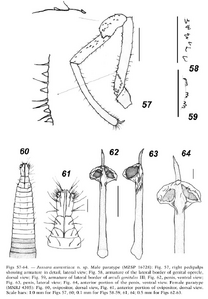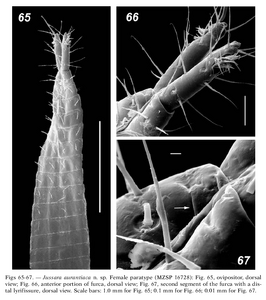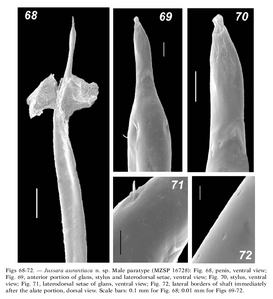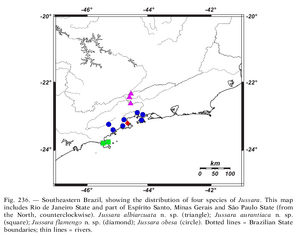| Jussara aurantiaca | |
|---|---|
 Jussara aurantiaca Tourinho & Kury, 2003 (from original description) | |
|
Suborder |
|
|
Superfamily |
|
|
Family |
|
|
Subfamily |
|
|
Genus |
|
Jussara aurantiaca Tourinho & Kury, 2003 is a member of the genus Jussara (Eupnoi:Sclerosomatidae).
Taxonomy[]
- J.a. Tourinho & Kury, 2003:225
Specimens[]
- J.a. male(1) (holotype) Museu Nacional/UFRJ; #4305
- J.a. male(1) (paratype) Museu de Zoologia da USP; #16880
- J.a. male(1) (paratype) Museu de Zoologia da USP; #16861
- J.a. male(3) + female (2) (paratype) Museu de Zoologia da USP; #16905
- J.a. male(3) + female (3) (paratype) Museu de Zoologia da USP; #16728
Diagnosis[]
(from original description)
Eye mound and legs black, body and dorsal surface of trochanters of leg II orange (fresh specimens reddish-orange), ventral surface of trochanters of legs I to IV black, lateral borders sometimes orange. Carapace showing a stripe in lateral borders, and an arch lighter than carapace forming an inverted V anterior to the eye mound (Figs 50, 52-54). Pedipalps and chelicerae pale yellow. Femoral formula: 1/3-4/1/1. Inner apophysis of patella smaller than the patella (20% of the length of the patella) (Fig. 57).
Description[]
(from original description)
Male[]
- Measurements. Body 4.3 mm, carapace 1.2 mm, dorsal scute 2.9 mm, chelicera 1.8 mm, pedipalp 5.8 mm, penis 1.8 mm. Colour. Ventral and dorsal surfaces orange (Figs 50, 53).
- Dorsal surface. Surface densely granular. Supracheliceral laminae distally armed with blunt granules (Fig. 55). Eye mound armed with two rows of sharp-pointed granules.
- Ventral surface. Surface densely granular. Lateral borders of the genital operculum armed with a row of one to three-pointed sharp granules (Fig. 58). Lateral borders of arculi genitales III armed with a row of three-pointed blunt granules (Fig. 59).
- Chelicera. Ventrobasal spine of basichelicerite sharp-pointed (Fig. 56).
- Pedipalp. As in J. albiarcuata except for: inner apophysis of the patella unarmed (Fig. 57).
- Legs. Femoral formula 1/3/1/1.
- Penis. Shaft 3 times wider than glans (Figs 62-63, 68), lateral borders of the shaft covered with slit-shaped depressions, reaching winglet area in dorsal view (Fig. 72). Winglets rounded-trapezoidal, expanded laterally, and not very prolonged longitudinally, lateral borders truncated, posterior margin strongly concave. Right and left units totally fused in ventral view (Figs 64, 68). Glans surface covered with simple pores (Fig. 71), two pairs of lateral setae, superior pair inserted more anteriorly (Fig. 69). Stylus straight (Figs 69-70).
Female[]
- Measurements. Body 4.8 mm, carapace 1.2 mm, dorsal scute 3.1 mm, chelicera 1.6 mm, pedipalp 5.6 mm, ovipositor 2.3 mm.
- Colour. As in the male except for a black spot on the anterior margin of the carapace (Figs 53-54).
- Dorsal and ventral surfaces. As in the female of J. albiarcuata (Figs 53-54).
- Chelicera and pedipalp. As in the male.
- Legs. Femoral formula 1/4/1/1.
- Ovipositor. Body with nine to thirteen segments (Figs 60, 65). Second segment of furca with a distal lyrifissure (Figs 61, 66-67).
Remarks[]
J. aurantiaca can be recognised and separated externally from J. avati and J. rosea by having the trochanters of legs II black in ventral view and yellow with black borders in dorsal view; and internally by the following characters of the penis: winglets rounded-trapezoidal, anterior margin of winglets rounded and lateral borders truncated, posterior margin strongly concave.
Notes[]
- Location: Brazil: São Paulo, São Sebastião and Ilha Bela
Literature[]
References[]
- ↑ Tourinho, A.L., & Kury, A.B., 2003. A review of Jussara, with descriptions of six new species (Arachnida, Opiliones, Sclerosomatidae) from Brazil. Tropical Zoology, 16(2): 209-275.



